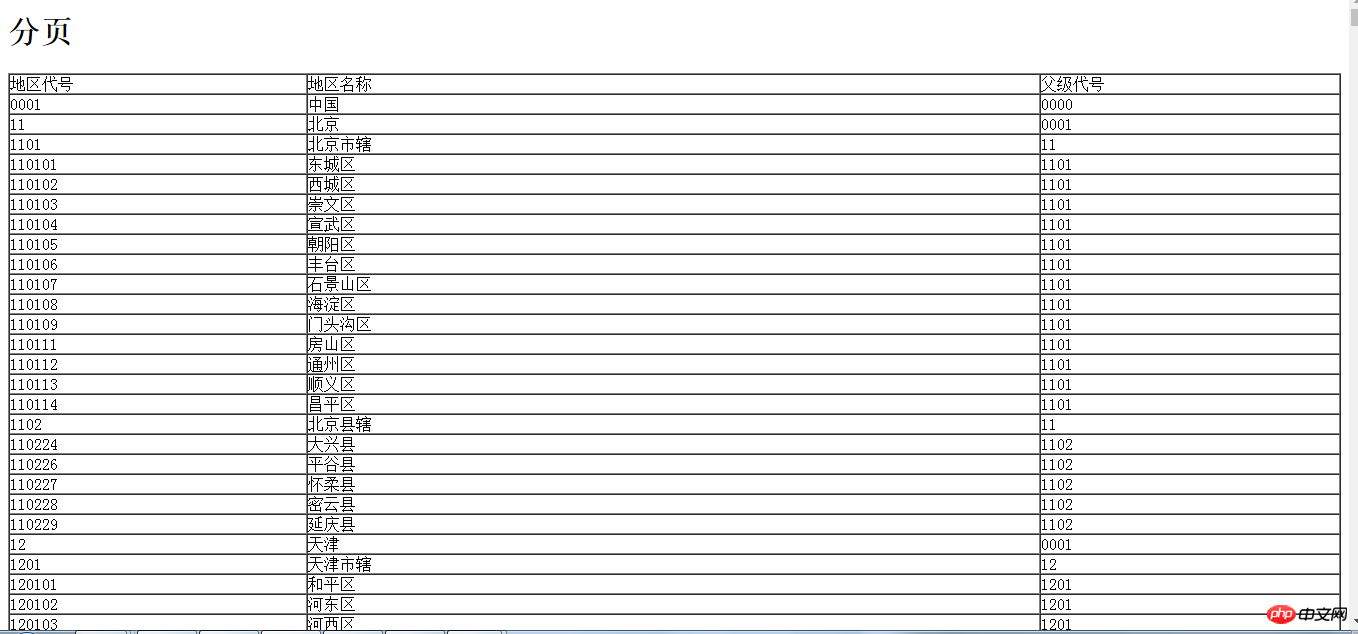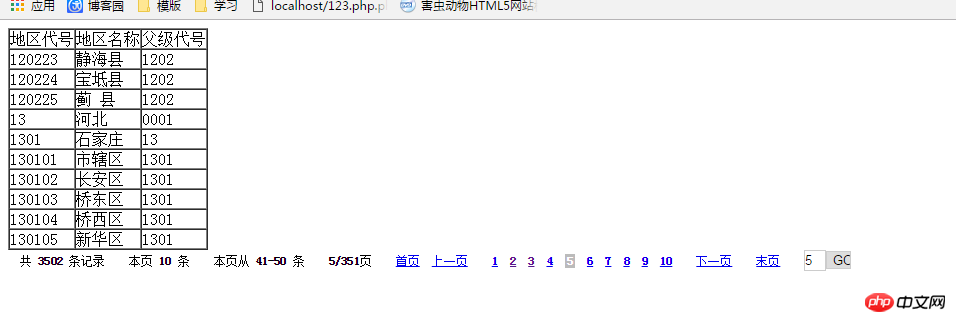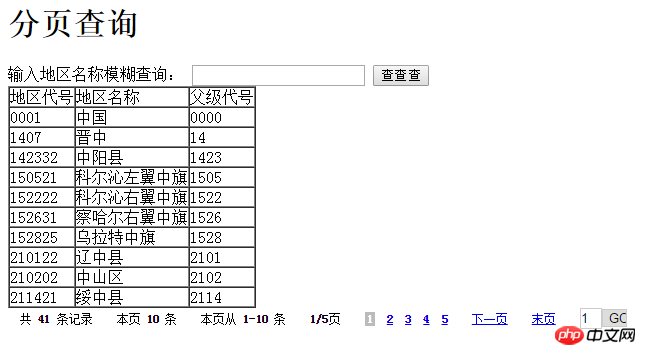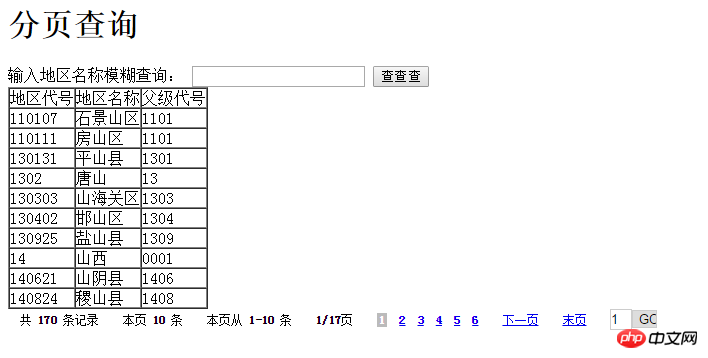以下就是php分页代码
<!DOCTYPE html PUBLIC "-//W3C//DTD XHTML 1.0 Transitional//EN" "http://www.w3.org/TR/xhtml1/DTD/xhtml1-transitional.dtd">
<html xmlns="http://www.w3.org/1999/xhtml">
<head>
<meta http-equiv="Content-Type" content="text/html; charset=utf-8" />
<title>无标题文档</title>
</head>
<body>
<h1>分页</h1>
<table width="100%" border="1" cellpadding="0" cellspacing="0">
<tr>
<td>地区代号</td>
<td>地区名称</td>
<td>父级代号</td>
</tr> <?php
include ("db.class.php");
$db = new db();
$sql = "select * from chinastates ";
$arr = $db->Query($sql);//默认=1可以不写
foreach($arr as $v)
{
echo "<tr>
<td>{$v[0]}</td>
<td>{$v[1]}</td>
<td>{$v[2]}</td>
</tr>";
}
?>
</table> </body>
图:
立即学习“PHP免费学习笔记(深入)”;

include ("page.class.php");
//查总条数
$sz = "select count(*) from chinastates";
$az = $db->Query($sz);
//1.造对象
$page = new page($az[0][0],10);
//一般只写两个参数,第一个数据的总条数
//取两个索引0:先取索引0二维数组,取到一位数组后取索引0
//第二个参数,显示10条
$sql = "select * from chinastates ".$page->limit;
//2.直接在sql语句后面拼接上$page(分页类)里面的limit,就可以完成分页
$arr = $db->Query($sql);//默认=1可以不写
<?php //3.输出分页信息 echo $page->fpage(); //分页对象中的fpage()方法 ?>
总代码:
<!DOCTYPE html PUBLIC "-//W3C//DTD XHTML 1.0 Transitional//EN" "http://www.w3.org/TR/xhtml1/DTD/xhtml1-transitional.dtd">
<html xmlns="http://www.w3.org/1999/xhtml">
<head>
<title>无标题文档</title>
</head>
<body>
<h1>分页查询</h1>
<table border="1" cellpadding="0" cellspacing="0">
<tr>
<td>地区代号</td>
<td>地区名称</td>
<td>父级代号</td>
</tr>
<?php
include ("DBDA.class.php");
//引用封装类
$db = new db();
//造对象
include "page.class.php";
//引用page工具
$aall = "select count(*) from chinastates";
//查询所有数据
$arr = $db->Query($aall);
//调用sql,返回一个数组,
$page = new page($arr[0][0],10);
//page类对象,每页显示10条
$sql = "select * from chinastates ".$page->limit;
//分页查询,page类调用limit
$ar = $db->Query($sql);
//执行,并返回一个数组(数据)
foreach ($ar as $v)
//遍历
{
echo" <tr>
<td>{$v[0]}</td>
<td>{$v[1]}</td>
<td>{$v[2]}</td>
</tr>
";
}
//显示
?>
</table>
<p>
<?php
echo $page->fpage();
//直接输出page类里面的fpage()(输出分页信息)
?>
</p>
</body>
</html>
最后的完成图:

查询关键字,在本页分页显示!
首先form表单:
<form action="fenyechaxun.php" method="get">
//提交给当前页面,用get传递
<p>
输入地区名称模糊查询:
<input type="text" name="area"/>
<input type="submit" value="查查查"/>
</p>
</form>分页查询的条件
$tj = "1 = 1 ";
//条件恒变量
if(!empty($_GET["area"]))
//判断传过来的是否非空
{
$r = $_GET["area"];
//为了防止双引号有冲突,给变量
$tj = "areaname like '%{$r}%' ";
//条件改变
}
查询语句也需要改变一下:
$aall = "select count(*) from chinastates WHERE {$tj}";
//查询所有数据
$sql = "select * from chinastates WHERE {$tj} ".$page->limit;
//分页查询,page类调用limit输出:
<p>
<?php
echo $page->fpage();
//直接输出page类里面的fpage()(输出分页信息)
?>
</p>
上图:

查询的数据也是以分页的形式:

| 地区代号 | 地区名称 | 父级代号 |
| {$v[0]} | {$v[1]} | {$v[2]} |
echo $page->fpage();
//直接输出page类里面的fpage()(输出分页信息)
?>
/**
file: page.class.php
完美分页类 Page
*/
class Page {
private $total; //数据表中总记录数
private $listRows; //每页显示行数
private $limit; //SQL语句使用limit从句,限制获取记录个数,查数据要查哪几条;limit(0,10)跳过第0条,取10条
private $uri; //自动获取url的请求地址
private $pageNum; //总页数
private $page; //当前页
private $config = array(
'head' => "条记录",
'prev' => "上一页",
'next' => "下一页",
'first'=> "首页",
'last' => "末页"
);
//可以修改的信息
//在分页信息中显示内容,可以自己通过set()方法设置
private $listNum = 10; //默认分页列表显示的个数,下面列表要显示多少条,10个
/**
构造方法,可以设置分页类的属性
@param int $total 计算分页的总记录数
@param int $listRows 可选的,设置每页需要显示的记录数,默认为25条
@param mixed $query 可选的,为向目标页面传递参数,可以是数组,也可以是查询字符串格式
@param bool $ord 可选的,默认值为true, 页面从第一页开始显示,false则为最后一页
*/
public function __construct($total, $listRows=25, $query="", $ord=true){
$this->total = $total;
$this->listRows = $listRows;
$this->uri = $this->getUri($query);
//自动获取游览器地址
$this->pageNum = ceil($this->total / $this->listRows);//(总共多少条数据/每页显示几条)ceil:向上取整
//取成员变量,$ord=ture首页
/*以下判断用来设置当前面*/
//去当前页
if(!empty($_GET["page"])) {
$page = $_GET["page"];
}else{
if($ord)
$page = 1;
else
$page = $this->pageNum;
}
if($total > 0) {
if(preg_match('/\D/', $page) ){
$this->page = 1;
}else{
$this->page = $page;
}
}else{
$this->page = 0;
}
$this->limit = "LIMIT ".$this->setLimit();
//LIMIT 10,10
}
/**
用于设置显示分页的信息,可以进行连贯操作
@param string $param 是成员属性数组config的下标
@param string $value 用于设置config下标对应的元素值
@return object 返回本对象自己$this, 用于连惯操作
*/
function set($param, $value){
if(array_key_exists($param, $this->config)){
$this->config[$param] = $value;
}
return $this;
}
/* 不是直接去调用,通过该方法,可以使用在对象外部直接获取私有成员属性limit和page的值 */
function __get($args){
if($args == "limit" || $args == "page")
return $this->$args;
else
return null;
}
/**
按指定的格式输出分页
@param int 0-7的数字分别作为参数,用于自定义输出分页结构和调整结构的顺序,默认输出全部结构
@return string 分页信息内容
*/
function fpage(){
$arr = func_get_args(); //用户参数
$html[0] = " 共 {$this->total} {$this->config["head"]} ";
$html[1] = " 本页 ".$this->disnum()." 条 ";
$html[2] = " 本页从 {$this->start()}-{$this->end()} 条 ";
$html[3] = " {$this->page}/{$this->pageNum}页 ";
$html[4] = $this->firstprev();
$html[5] = $this->pageList();
$html[6] = $this->nextlast();
$html[7] = $this->goPage();
$fpage = '
';
if(count($arr) $arr = array(0, 1,2,3,4,5,6,7);
for($i = 0; $i $fpage .= $html[$arr[$i]];
$fpage .= '
/* 在对象内部使用的私有方法,用于自动获取访问的当前URL */
private function getUri($query){
$request_uri = $_SERVER["REQUEST_URI"];
$url = strstr($request_uri,'?') ? $request_uri : $request_uri.'?';
if(is_array($query))
$url .= http_build_query($query);
else if($query != "")
$url .= "&".trim($query, "?&");
$arr = parse_url($url);
if(isset($arr["query"])){
parse_str($arr["query"], $arrs);
unset($arrs["page"]);
$url = $arr["path"].'?'.http_build_query($arrs);
}
if(strstr($url, '?')) {
if(substr($url, -1)!='?')
$url = $url.'&';
}else{
$url = $url.'?';
}
return $url;
}
/* 在对象内部使用的私有方法,用于获取当前页开始的记录数 */
private function start(){
if($this->total == 0)
return 0;
else
return ($this->page-1) * $this->listRows+1;
}
/* 在对象内部使用的私有方法,用于获取当前页结束的记录数 */
private function end(){
return min($this->page * $this->listRows, $this->total);
}
/* 在对象内部使用的私有方法,用于获取上一页和首页的操作信息 */
private function firstprev(){
if($this->page > 1) {
$str = " uri}page=1'>{$this->config["first"]} ";
$str .= "uri}page=".($this->page-1)."'>{$this->config["prev"]} ";
return $str;
}
}
/* 在对象内部使用的私有方法,用于获取页数列表信息 */
private function pageList(){
$linkPage = " ";
$inum = floor($this->listNum/2);
/*当前页前面的列表 */
for($i = $inum; $i >= 1; $i--){
$page = $this->page-$i;
if($page >= 1)
$linkPage .= "uri}page={$page}'>{$page} ";
}
/*当前页的信息 */
if($this->pageNum > 1)
$linkPage .= "{$this->page} ";
/*当前页后面的列表 */
for($i=1; $i $page = $this->page+$i;
if($page pageNum)
$linkPage .= "uri}page={$page}'>{$page} ";
else
break;
}
$linkPage .= '';
return $linkPage;
}
/* 在对象内部使用的私有方法,获取下一页和尾页的操作信息 */
private function nextlast(){
if($this->page != $this->pageNum) {
$str = " uri}page=".($this->page+1)."'>{$this->config["next"]} ";
$str .= " uri}page=".($this->pageNum)."'>{$this->config["last"]} ";
return $str;
}
}
/* 在对象内部使用的私有方法,用于显示和处理表单跳转页面 */
private function goPage(){
if($this->pageNum > 1) {
return ' ';
}
}
/* 在对象内部使用的私有方法,用于获取本页显示的记录条数 */
private function disnum(){
if($this->total > 0){
return $this->end()-$this->start()+1;
}else{
return 0;
}
}
}
<!DOCTYPE html PUBLIC "-//W3C//DTD XHTML 1.0 Transitional//EN" "http://www.w3.org/TR/xhtml1/DTD/xhtml1-transitional.dtd">
<html xmlns="http://www.w3.org/1999/xhtml">
<head>
<meta http-equiv="Content-Type" content="text/html; charset=utf-8" />
<title>无标题文档</title>
</head>
<body>
<h1>分页</h1>
<table width="100%" border="1" cellpadding="0" cellspacing="0">
<tr>
<td>地区代号</td>
<td>地区名称</td>
<td>父级代号</td>
</tr> <?php
include ("db.class.php");
$db = new db();
$sql = "select * from chinastates ";
$arr = $db->Query($sql);//默认=1可以不写
foreach($arr as $v)
{
echo "<tr>
<td>{$v[0]}</td>
<td>{$v[1]}</td>
<td>{$v[2]}</td>
</tr>";
}
?>
</table> </body>
图:
立即学习“PHP免费学习笔记(深入)”;

include ("page.class.php");
//查总条数
$sz = "select count(*) from chinastates";
$az = $db->Query($sz);
//1.造对象
$page = new page($az[0][0],10);
//一般只写两个参数,第一个数据的总条数
//取两个索引0:先取索引0二维数组,取到一位数组后取索引0
//第二个参数,显示10条
$sql = "select * from chinastates ".$page->limit;
//2.直接在sql语句后面拼接上$page(分页类)里面的limit,就可以完成分页
$arr = $db->Query($sql);//默认=1可以不写
<?php //3.输出分页信息 echo $page->fpage(); //分页对象中的fpage()方法 ?>
总代码:
<!DOCTYPE html PUBLIC "-//W3C//DTD XHTML 1.0 Transitional//EN" "http://www.w3.org/TR/xhtml1/DTD/xhtml1-transitional.dtd">
<html xmlns="http://www.w3.org/1999/xhtml">
<head>
<title>无标题文档</title>
</head>
<body>
<h1>分页查询</h1>
<table border="1" cellpadding="0" cellspacing="0">
<tr>
<td>地区代号</td>
<td>地区名称</td>
<td>父级代号</td>
</tr>
<?php
include ("DBDA.class.php");
//引用封装类
$db = new db();
//造对象
include "page.class.php";
//引用page工具
$aall = "select count(*) from chinastates";
//查询所有数据
$arr = $db->Query($aall);
//调用sql,返回一个数组,
$page = new page($arr[0][0],10);
//page类对象,每页显示10条
$sql = "select * from chinastates ".$page->limit;
//分页查询,page类调用limit
$ar = $db->Query($sql);
//执行,并返回一个数组(数据)
foreach ($ar as $v)
//遍历
{
echo" <tr>
<td>{$v[0]}</td>
<td>{$v[1]}</td>
<td>{$v[2]}</td>
</tr>
";
}
//显示
?>
</table>
<p>
<?php
echo $page->fpage();
//直接输出page类里面的fpage()(输出分页信息)
?>
</p>
</body>
</html>
最后的完成图:

查询关键字,在本页分页显示!
首先form表单:
<form action="fenyechaxun.php" method="get">
//提交给当前页面,用get传递
<p>
输入地区名称模糊查询:
<input type="text" name="area"/>
<input type="submit" value="查查查"/>
</p>
</form>分页查询的条件
$tj = "1 = 1 ";
//条件恒变量
if(!empty($_GET["area"]))
//判断传过来的是否非空
{
$r = $_GET["area"];
//为了防止双引号有冲突,给变量
$tj = "areaname like '%{$r}%' ";
//条件改变
}
查询语句也需要改变一下:
$aall = "select count(*) from chinastates WHERE {$tj}";
//查询所有数据
$sql = "select * from chinastates WHERE {$tj} ".$page->limit;
//分页查询,page类调用limit输出:
<p>
<?php
echo $page->fpage();
//直接输出page类里面的fpage()(输出分页信息)
?>
</p>
上图:

查询的数据也是以分页的形式:

| 地区代号 | 地区名称 | 父级代号 |
| {$v[0]} | {$v[1]} | {$v[2]} |
echo $page->fpage();
//直接输出page类里面的fpage()(输出分页信息)
?>
/**
file: page.class.php
完美分页类 Page
*/
class Page {
private $total; //数据表中总记录数
private $listRows; //每页显示行数
private $limit; //SQL语句使用limit从句,限制获取记录个数,查数据要查哪几条;limit(0,10)跳过第0条,取10条
private $uri; //自动获取url的请求地址
private $pageNum; //总页数
private $page; //当前页
private $config = array(
'head' => "条记录",
'prev' => "上一页",
'next' => "下一页",
'first'=> "首页",
'last' => "末页"
);
//可以修改的信息
//在分页信息中显示内容,可以自己通过set()方法设置
private $listNum = 10; //默认分页列表显示的个数,下面列表要显示多少条,10个
/**
构造方法,可以设置分页类的属性
@param int $total 计算分页的总记录数
@param int $listRows 可选的,设置每页需要显示的记录数,默认为25条
@param mixed $query 可选的,为向目标页面传递参数,可以是数组,也可以是查询字符串格式
@param bool $ord 可选的,默认值为true, 页面从第一页开始显示,false则为最后一页
*/
public function __construct($total, $listRows=25, $query="", $ord=true){
$this->total = $total;
$this->listRows = $listRows;
$this->uri = $this->getUri($query);
//自动获取游览器地址
$this->pageNum = ceil($this->total / $this->listRows);//(总共多少条数据/每页显示几条)ceil:向上取整
//取成员变量,$ord=ture首页
/*以下判断用来设置当前面*/
//去当前页
if(!empty($_GET["page"])) {
$page = $_GET["page"];
}else{
if($ord)
$page = 1;
else
$page = $this->pageNum;
}
if($total > 0) {
if(preg_match('/\D/', $page) ){
$this->page = 1;
}else{
$this->page = $page;
}
}else{
$this->page = 0;
}
$this->limit = "LIMIT ".$this->setLimit();
//LIMIT 10,10
}
/**
用于设置显示分页的信息,可以进行连贯操作
@param string $param 是成员属性数组config的下标
@param string $value 用于设置config下标对应的元素值
@return object 返回本对象自己$this, 用于连惯操作
*/
function set($param, $value){
if(array_key_exists($param, $this->config)){
$this->config[$param] = $value;
}
return $this;
}
/* 不是直接去调用,通过该方法,可以使用在对象外部直接获取私有成员属性limit和page的值 */
function __get($args){
if($args == "limit" || $args == "page")
return $this->$args;
else
return null;
}
/**
按指定的格式输出分页
@param int 0-7的数字分别作为参数,用于自定义输出分页结构和调整结构的顺序,默认输出全部结构
@return string 分页信息内容
*/
function fpage(){
$arr = func_get_args(); //用户参数
$html[0] = " 共 {$this->total} {$this->config["head"]} ";
$html[1] = " 本页 ".$this->disnum()." 条 ";
$html[2] = " 本页从 {$this->start()}-{$this->end()} 条 ";
$html[3] = " {$this->page}/{$this->pageNum}页 ";
$html[4] = $this->firstprev();
$html[5] = $this->pageList();
$html[6] = $this->nextlast();
$html[7] = $this->goPage();
$fpage = '
';
if(count($arr) $arr = array(0, 1,2,3,4,5,6,7);
for($i = 0; $i $fpage .= $html[$arr[$i]];
$fpage .= '
/* 在对象内部使用的私有方法,用于自动获取访问的当前URL */
private function getUri($query){
$request_uri = $_SERVER["REQUEST_URI"];
$url = strstr($request_uri,'?') ? $request_uri : $request_uri.'?';
if(is_array($query))
$url .= http_build_query($query);
else if($query != "")
$url .= "&".trim($query, "?&");
$arr = parse_url($url);
if(isset($arr["query"])){
parse_str($arr["query"], $arrs);
unset($arrs["page"]);
$url = $arr["path"].'?'.http_build_query($arrs);
}
if(strstr($url, '?')) {
if(substr($url, -1)!='?')
$url = $url.'&';
}else{
$url = $url.'?';
}
return $url;
}
/* 在对象内部使用的私有方法,用于获取当前页开始的记录数 */
private function start(){
if($this->total == 0)
return 0;
else
return ($this->page-1) * $this->listRows+1;
}
/* 在对象内部使用的私有方法,用于获取当前页结束的记录数 */
private function end(){
return min($this->page * $this->listRows, $this->total);
}
/* 在对象内部使用的私有方法,用于获取上一页和首页的操作信息 */
private function firstprev(){
if($this->page > 1) {
$str = " uri}page=1'>{$this->config["first"]} ";
$str .= "uri}page=".($this->page-1)."'>{$this->config["prev"]} ";
return $str;
}
}
/* 在对象内部使用的私有方法,用于获取页数列表信息 */
private function pageList(){
$linkPage = " ";
$inum = floor($this->listNum/2);
/*当前页前面的列表 */
for($i = $inum; $i >= 1; $i--){
$page = $this->page-$i;
if($page >= 1)
$linkPage .= "uri}page={$page}'>{$page} ";
}
/*当前页的信息 */
if($this->pageNum > 1)
$linkPage .= "{$this->page} ";
/*当前页后面的列表 */
for($i=1; $i $page = $this->page+$i;
if($page pageNum)
$linkPage .= "uri}page={$page}'>{$page} ";
else
break;
}
$linkPage .= '';
return $linkPage;
}
/* 在对象内部使用的私有方法,获取下一页和尾页的操作信息 */
private function nextlast(){
if($this->page != $this->pageNum) {
$str = " uri}page=".($this->page+1)."'>{$this->config["next"]} ";
$str .= " uri}page=".($this->pageNum)."'>{$this->config["last"]} ";
return $str;
}
}
/* 在对象内部使用的私有方法,用于显示和处理表单跳转页面 */
private function goPage(){
if($this->pageNum > 1) {
return ' ';
}
}
/* 在对象内部使用的私有方法,用于获取本页显示的记录条数 */
private function disnum(){
if($this->total > 0){
return $this->end()-$this->start()+1;
}else{
return 0;
}
}
}
更多php分页查询 - 附php分页代码文章,请关注php中文网

PHP怎么学习?PHP怎么入门?PHP在哪学?PHP怎么学才快?不用担心,这里为大家提供了PHP速学教程(入门到精通),有需要的小伙伴保存下载就能学习啦!

Copyright 2014-2025 https://www.php.cn/ All Rights Reserved | php.cn | 湘ICP备2023035733号